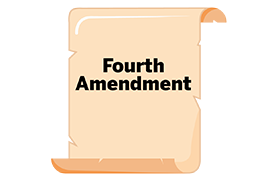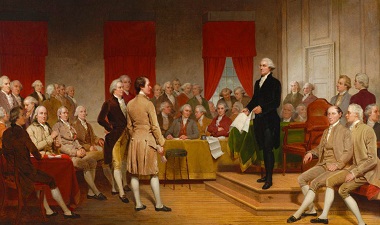
Getting Started
This module includes an Unboxing the Constitution video (6 min), Inside the Constitution video (7 min), student activities, and a learning project. Download the Teachers Guide and the Student Content Guide for more details on content and implementation. Course materials are provided in Google documents, as well as printable PDFs.
A preview of the module can be accessed below.
Topics covered include:
- Freedom of speech
- Freedom of religion
- Freedom of petition and assembly
- Marketplace of ideas

Vocabulary
At the beginning of each module, students are presented with vocabulary words and definitions.
Concept Words
Concept words are conceptually related to the big ideas in what they’re learning. These connect directly to the core concepts or themes of the lesson or unit and help students grasp the main ideas and how everything fits together.
- assembly: gathering together as a group for a common purpose
- clause: a separate section
- concurring opinion: a written statement by a justice explaining why he or she agrees with the majority opinion for different reasons
- dissenting opinion: a written statement by a justice explaining why he or she disagrees with the court’s majority opinion
- freedom of conscience: the right to think and act on one’s own beliefs
Speed Bump Words
Speed bump words are words that aren’t central to the concept being taught, but if students don’t understand them, they may struggle to comprehend the text or lesson. These words can help shape students' overall understanding of the topic.
- abridge: to prevent or stop
- defamation: sharing false or cruel information about someone on purpose that damages their reputation
- grievance: a complaint over something
- imminent: happening right away
- intent: with purpose
- lawless: not following the law
- liberty: freedom
- obscenity: materials or actions that are offensive or indecent
- petition: a formal written request
- press: people who write or create news stories
- redress: to fix a wrong
- threat: a statement that makes others feel like something bad will happen
- violate: an action that goes against somethin

Topic 1: The Five Freedoms in the First Amendment
The text of the First Amendment is simple and powerful:
Congress shall make no law respecting an establishment of religion, or prohibiting the free exercise thereof; or abridging the freedom of speech, or of the press; or the right of the people peaceably to assemble, and to petition the Government for a redress of grievances.
These words reference fundamental freedoms for all citizens. What are those freedoms? And why are they important?
10.1: Activate Prior Knowledge
To start engaging with the content of this module, students will brainstorm words, ideas, and phrases that can define “marketplace of ideas” through sketches and word lists.
Unboxing the Constitution
In this Unboxing the Constitution video Lucy explores the events, ideas, and influential people that are related to the First Amendment.
10.2: Five Freedoms
Students will deepen their understanding of the various parts of the First Amendment by categorizing different scenarios by which of the five freedoms they represent.
10.3: Protecting Freedom
Students watch the Inside the Constitution video to learn about the reasons why the framers chose to protect the freedoms found in the First Amendment and use the Protecting Freedom Video Notes to organize their thoughts.
Inside the Constitution
10.4: Religious Freedom
Students will explore the connections between the Virginia Statute for Religious Freedom and the First Amendment. What similarities and differences are there between the two documents?
10.5: Freedom of Assembly and Petition
What else is included in the First Amendment? Students will dive into the additional rights included in the First Amendment, including the right to petition and assembly. Implementation suggestions for this activity can be found in the Teachers Guide and Student Content Guide.
10.6: Closing Activity
Students will check in on the Key Question(s).

Topic 2: A "Marketplace of Ideas?"
Throughout the 20th century, the Supreme Court applied the First Amendment’s protection of free speech to new contexts. As the century wore on, the Court also shifted from limited protections of free speech to more robust protections. One key idea that helped drive these changes was introduced in the early 20th century by Justice Oliver Wendell Holmes—the concept of the "marketplace of ideas.”
10.7: A Marketplace of Ideas
In this activity, students will examine some quotes from key Supreme Court cases throughout history and look for common words and phrases that connect to big ideas from the First Amendment.
Review the Teachers Guide for implementation tips for this activity and others in this module.
10.8: Limits to Free Speech
What are some of the limits of free speech? Can you say whatever you want, whenever you want? Students will look at some cases to learn about times when the Supreme Court has placed limits on free speech. Implementation suggestions for this activity can be found in the Teachers Guide and Student Content Guide.
10.9: Civic Connection: Is This Speech Protected?
In this Civic Connection activity, students will examine real-life examples of free speech and decide if any limits are constitutionally justified. What are the key considerations you need to keep in mind when making these decisions?
10.10: Reflect
To end this module, students will revist the brainstorming activity from the beginning of the module to see how insights have grown thoughout the lesson.

Learning Project: First Amendment Time Capsule
In this activity, students will explore how pivotal Supreme Court cases and social movements have shaped how First Amendment rights are applied in today's society. Students will identify significant moments by creating a time capsule that captures key events, figures, and legal rulings that have defined the First Amendment throughout history.
When teams have completed their time capsules, have them share what they chose to include with the class. If time allows, consider having teams create an online presentation of their time capsules to share in a Gallery Walk.













